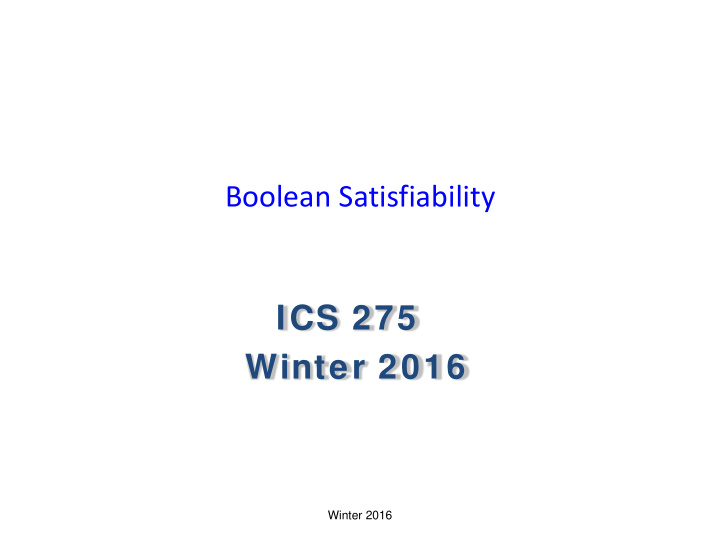



Boolean Satisfiability ICS 275 Winter 2016 Winter 2016
Winter 2016
Conflict Analysis: Implication Grpahs • The combination of these techniques makes sure that unit resolution is empowered every time a conflict arises and that the solver will not repeat any mistake. The identification of conflict–driven clauses is done through a process known as conflict analysis, which analyzes a trace of unit resolution known as the implication graph. Our csp conflict did not take arc-consistency into account In SAT, conflict-dirven analysis does. Winter 2016
Implication graphs = 1. {A,B} 2. {B,C} 3. { ¬ A, ¬ X, Y } 4. { ¬ A,X,Z} 5. { ¬ A, ¬ Y,Z} 6. { ¬ A,X, ¬ Z} 7. { ¬ A, ¬ Y, ¬ Z} Winter 2016
Deriving conflict clause • Every cut in the implication graph defines a conflict set as long as that cut seperates the decision variables (root nodes) from the contradiction (a leaf node). • Any node (variable assignment) with an outgoing edge that cross the cut will be in the conflict set. leading to conflict sets:{A=true,X=true}, {A=true, Y=true} and {A=true, Y=true,Z=true}.
Earliest minimal conflict? For the graph in Figure 3.7(b), {A = true} is a conflict cut. Conflict–driven clauses generated from cuts that contain exactly one variable assigned at the level of conflict are said to be asserting [ZMMM01]. Modern SAT solvers insist on learning only asserting clauses. Winter 2016
Where do we do with the conflict clauses? The process of adding a conflict–driven clause to the CNF is known as clause learning [MSS99, BS97, ZMMM01, BKS04]. A key question in this regard is when exactly to add this clause. Consider the termination tree in Figure 3.6 and the left most leaf node corresponding to the CNF |A,B,C,X. Unit resolution discovers a contradiction in this CNF and by analyzing the implication graph in Figure 3.7(a), we can identify the conflict–driven clause ¬ A ∨¬ X. The question now is: What to do next? Since the contradiction was discovered after setting variable X to true, we know that we have to at least undo that decision. Modern SAT solvers, however, will undo all decisions made after the assertion level, which is the second highest level in a conflict–driven clause. For example, in the clause ¬ A ∨ ¬ X, A was set at Level 0 and X was set at level 3. Hence, the assertion level is 0 in this case. If the clause contains only literals from one level, its assertion level is then − 1 by definition. The assertion level is special in the sense that it is the deepest level at which adding the conflict–driven clause would allow unit resolution to derive a new implication using that clause. This is the reason why modern SAT solvers would actually backtrack all the way to the assertion level, add the conflict–driven clause to the CNF, apply unit resolution, and then continue the search process. This particular method of performing non–chronological backtracking is referred to as far-backtracking [SBK05]. Winter 2016
DPLL and clause learning Winter 2016
UIP: Unique Implication points A UIP of a decision level in an implication graph is a variable setting at that decision level which lies on every path from the decision variable of that level to the contradiction. Intuitively, a UIP of a level is an assignment at the level that, by itself, is sufficient for implying the contradiction. In Figure 3.9, the variable setting 3/Y=true and 3/X=true would be UIPs as they lie on every path from the decision 3/X=true to the contradiction 3/{}. Winter 2016
Winter 2016
Winter 2016
Winter 2016
Winter 2016
Winter 2016
Winter 2016
Winter 2016
Winter 2016
Winter 2016
Winter 2016
Winter 2016
Winter 2016
Winter 2016
Winter 2016
Winter 2016
Winter 2016
Winter 2016
Winter 2016
Winter 2016
Winter 2016
Winter 2016
Winter 2016
Winter 2016
Winter 2016
Winter 2016
Winter 2016
Winter 2016
Winter 2016
Winter 2016
Winter 2016
Winter 2016
Winter 2016
Winter 2016
Winter 2016
Winter 2016
Winter 2016
Winter 2016
Winter 2016
Winter 2016
Winter 2016
Winter 2016
Winter 2016
Winter 2016
Winter 2016
Winter 2016
Benchmarks • Random • Crafted • Industrial Winter 2016
SAT race 2006 Winter 2016
Recommend
More recommend